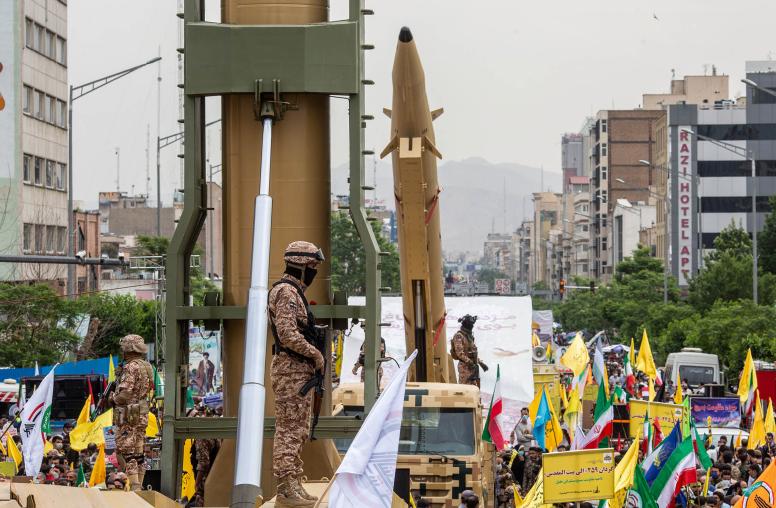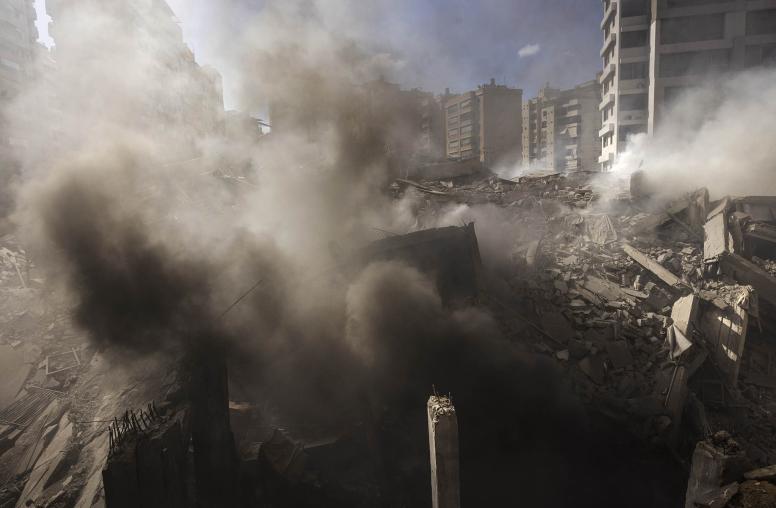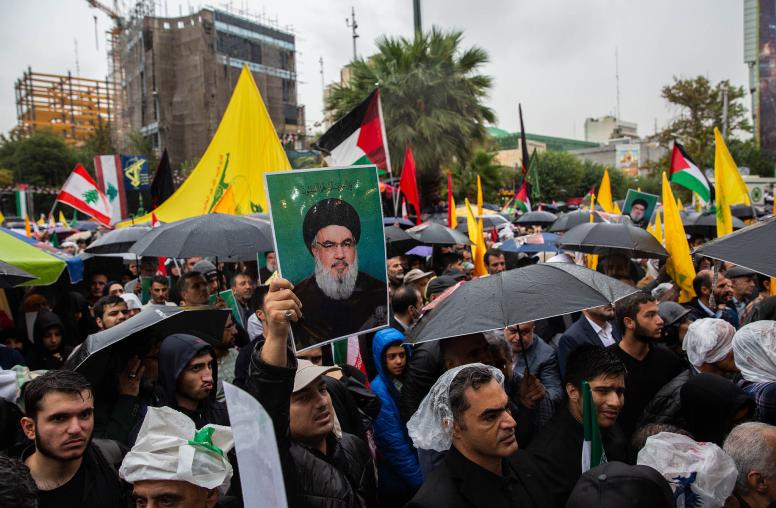Syria’s Alliance with Iran
Against a backdrop of growing instability in the Middle East, and despite continued pressure from the West, Syria’s alliance with Iran appears to be holding strong and perhaps even deepening. The United States has strongly criticized both Syria and Iran for contributing to the region’s volatility and, in particular, for playing a destabilizing role in each of three regional conflicts: Iraq, Lebanon, and Palestine.
This is the fifth in a series of USIPeace Briefings on Syria. The first, "Syria and Political Change," was published in December 2005. The second, "Syria and Political Change II," was published in March 2006. The third "Syria's Role in Lebanon" was published in November 2006, and the fourth "Syria's Relations with Iraq," was published in April 2007.
Recent U.S. overtures to both Syria and Iran raise the question of whether either country can be persuaded to forsake their longstanding alliance and adopt a more constructive role in the region.
Main Points:
- Spanning more than a quarter century, Syria’s alliance with Iran has proven to be quite durable. The alliance’s breadth has insured that the bilateral relationship is not merely a tactical "marriage of convenience." Rather, deepening ties in a variety of realms—strategic, political, economic, and cultural—attest to the growing strength of the alliance.
- Bilateral interests diverge in certain key respects. Syria’s Sunni-majority population has not warmed significantly to the alliance with Shiite Iran and vice-versa. As well, each country is aware that it could be used as a "bargaining chip" should the other seek to cut a deal with the West.
- While both countries’ interests could diverge in the long term, the current constellation of leadership in both Damascus and Tehran insures that the alliance will continue to endure over the next few years, particularly given their shared animosity toward the United States.
- Efforts to drive a "wedge" between Syria and Iran are unlikely to be successful under the current circumstances. While the two allies may participate in negotiations with the West on Iraq and other regional issues, they will not forsake their longstanding alliance—at least in the short term.
An Enduring Alliance
Increasingly bound by a series of overlapping interests in the Middle East and their joint antipathy to the West, Syria and Iran have forged an enduring alliance that has superseded the fundamental differences dividing the two countries (e.g., Arab versus Persian, secular versus theocratic, Sunni-majority versus Shiite). While the countries have been allies since the late 1970s, their alliance has strengthened noticeably over the past three years as both Syria and Iran have faced with mounting isolation from the West. Both countries strongly oppose the U.S. role in Iraq; they both support Hezbollah in Lebanon and Hamas in Palestine. Indeed, they are bound by shared enmity toward the United States, seeking instead to define a new Middle East order that rejects American influence in the region.
Cooperation between the two countries has increased in several spheres. Militarily, the countries signed a mutual defense pact in June 2006 (a text has never been released) and an additional military cooperation agreement in March 2007. (Earlier, in 2004, the countries signed a "strategic cooperation" agreement.) Security and military cooperation reportedly also includes Iranian missile sales to Syria, as well as ongoing intelligence cooperation with Tehran reportedly providing equipment and training to Syrian operatives.
Direct Iranian investment in Syria has increased to record levels over the past few years. The two countries have signed trade and economic cooperation agreements across numerous sectors from telecommunications to agriculture to petroleum, representing potentially $1–$3 billion in new Iranian investment. Joint Syrian-Iranian ventures currently include a newly opened $60 million car factory, Syria’s first domestically produced automobile, and the purchase of a new fleet of buses from Iran. There are also plans to build oil refineries, wheat silos, a cement plant, and to renovate the Kirkuk-Baniyas oil pipeline, which would carry oil from neighboring Iraq to the Syrian coast.
Cultural exchanges and cooperation are also on the rise. Iran currently operates at least two cultural centers (in Damascus and Latakia) and pours millions of dollars into the restoration of Shiite shrines located throughout Syria. An estimated 500,000–one million Iranian tourists make pilgrimages to these shrines annually. Private Iranian money is also funding a number of hawzas, Shiite seminaries, across Syria. Rumors circulating Syria that wealthy Iranian pilgrims are paying Syrians to convert to Shia Islam constitute a potentially ominous element of cultural cooperation.
Potential Sources of Tension
Over the longer term, there are several potential sources of tension that could weaken the Syrian-Iranian alliance. For example, the implicit popular divide between Sunni-majority Syrians and largely Shiite Iran underscores a key area of divergence. Iranian efforts to project Shiite religious influence could easily backfire in Syria where Salafist Islamist sentiment—which, at its most extreme, considers Shiites to be apostates—is on the rise. Mindful of simmering sectarian tensions, the Syrian regime will remain wary of Iranian attempts to promote Shiite religious and cultural influence in Syria. Hailing from a minority sect (the Alawites—a Shiite offshoot), Syrian President Bashar Assad likely understands that stoking these sectarian sentiments comes at his own peril. More broadly, at the popular level, neither the Syrian population nor their Iranian counterparts appears deeply vested in the alliance. Indeed, key elements in both the Syrian and Iranian populations likely consider engagement with the West as critical to ending their country’s isolation and therefore view the Syrian-Iranian alliance with mixed feelings at best.
Strategically, over the long term, the alliance could run aground if either partner seeks to "sell out" the other in the name of improving ties with the West. For example, some analysts speculate that Iran could negotiate a deal on its nuclear program that might entail forgoing its alliance with Damascus. By the same token, Syria might cut a deal with the West to relieve its isolation or to insure regime survival. Such a deal might result in Damascus abandoning Iranian equities (namely Hezbollah) in Lebanon, or in Syria making peace with Israel. In the first case, Iran’s relationship with Hezbollah, facilitated by Syria’s "middle man" role, is one of the most important elements of Tehran’s alliance with Damascus—certainly not to be sacrificed from Tehran’s standpoint. On the latter issue, Damascus has professed its desire to resume negotiations with Israel, while Iranian President Ahmedinejad has called for Israel to be "wiped off the map." While admittedly distant possibilities, either scenario—Syria abandoning Hezbollah or making peace with Israel—would deal a serious, possibly fatal, blow to the alliance. However, both sides likely remain wary of abandonment by the other in the name of improving ties with the West.
No "Wedge" for Now
While potential sources for tension exist, Syria’s alliance with Iran will likely hold strong for the near to medium term. Although Iran may be the "senior partner" in the alliance, both Damascus and Tehran remain steadfast in their mutual enmity and deep distrust of the United States. Attempts to "peel" one partner away from the alliance are unlikely to be successful for a number of reasons. First, Iran has exerted significant effort to ground the alliance, investing millions of dollars and solidifying relations across a number of spheres. The resulting web of military, political, and economic ties will be increasingly difficult to unravel. Over time, these linkages—particularly the economic ones—are likely to become mutually reinforcing, further entrenching the relationship. Indeed, Syrian workers may rely increasingly on Iranian investment for training and jobs. As well, joint infrastructure projects such as pipelines and railways that literally link the countries could further solidify ties.
Secondly, the current leadership in both Damascus and Tehran is decidedly more hardline and less prone to engagement with the West. As long as both Ahmedinejad and Assad are in power, the alliance will likely remain a key priority for both governments. Together, these hardliners and their entrenched constituencies will help to propel the alliance forward. While the centers of power are more divided and diffuse in Iran, hardliners such as President Ahmedinejad appear to hold sway regarding Iran’s deepening ties to Syria. For them, the alliance is the manifestation of a deeper ideology that totally rejects the West and views the United States as a key enemy in the region. Meanwhile, Syrian President Bashar Assad has made a clear decision to ally more closely to Iran than his father, Hafez, who helped initiate the alliance nearly thirty years ago. Syria’s deeper ties to Iran stem from Damascus’s growing alliance with (and reliance on) Hezbollah, its own serious economic woes, and its continued isolation from the West. Indeed, Bashar has encouraged the relationship to blossom at the expense of Syria’s Arab alliances—perhaps tying Damascus to Tehran even more closely.
Finally, both Syria and Iran appear to be growing increasingly defiant in the face of U.S. difficulties in Iraq, a badly-weakened pro-Western government in Lebanon, and escalating tensions among the Palestinians in the territories. In each instance, both Syria and Iran perceive potential opportunities to deepen their influence and roll back the projection of U.S. power in the region. They are therefore unlikely to step back from the alliance, but instead can be expected to accelerate and deepen linkages as they pursue their shared agenda in the region.
Taken together, these factors suggest that a significant investment of diplomatic (and likely financial) capital would be necessary to drive a wedge between Syria and Iran. Although Syria may be the weaker partner in the relationship, "flipping" Damascus—enticing it away from its alliance with Tehran—would be a difficult undertaking. While there are clear divergences of interests dividing the two countries, it appears at this point that far more binds the two allies than pulls them apart.
This USIPeace Briefing was written by Mona Yacoubian, director of the Institute's Syria Working Group and special adviser to the Muslim World Initiative. The views expressed here are not necessarily those of the Institute, which does not advocate specific policies.



